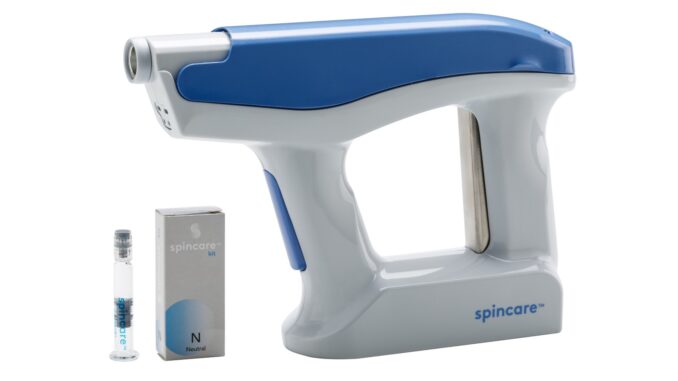
An Israeli startup is using electrospinning technology to transform the current wound-healing process.
Nanomedic’s Spincare device, which resembles a large staple gun, deploys the electrostatically charged method to charge up a proprietary polymer from a disposable ampule and sprays nanofibers onto wounds as a protective, second skin while they heal.
“Wherever the patient is, we can print our electrospun healing fiber matrix directly on the wound. That has a lot of advantages to enhance the healing process,” said Nanomedic CEO Chen Barak, who has a PhD in biomedical engineering. “You apply it once, so there is no dressing change needed. Patients can take regular showers after 24 to 48 hours. And when the skin underneath is healed, our layer peels off on its own.”
No dressing changes means less pain, especially for burn victims. The matrix is applied from about 20 centimeters (8 inches) away and adheres completely to any wound, regardless of hape or size.
“This is very efficient even on faces, hands and moving parts of the body, and allows free movement unlike many kinds of dressings,” Barak said.
The electrospun fiber used in Spincare bio-mimics the structure of skin tissue, thus accelerating healing and reducing scarring. Another big advantage is that healthcare professionals can assess the healing process without removing a bandage because the matrix becomes transparent after it is applied.
SpinCare “addresses the individual needs of our patients by providing them a maximum of mobility and comfort during their healing period,” according to Dr. Alexandra Schulz, a plastic surgeon in Cologne, Germany’s Clinic for Plastic Surgery and Hand Surgery.
“It fits perfectly each individual wound size and surface and can be applied easily by health care professionals,” she said. “This dressing provides an ideal environment for wound healing in superficial to partial thickness wound depth. To my mind, Spincare is a modern solution for wound treatment.”
A new approach in wound care
The Nanomedic device was first conceptualized by Barak’s team about seven years ago, but the company was not officially founded until 2018.
Its unique handheld device can be used not only in hospitals, but also on the scene of emergencies. It can additionally be stored on ambulances and in public buildings.
“Electrospinning machines are big and highly sophisticated. To use them for wound care, we needed to miniaturize the technology, which hasn’t been done before,” Barak said. “This is a completely new innovative product for wound care. The market is full of dressings, but our device is the only one that manufactures the matrix directly on the wound, covering and protecting it during the healing process.”

Even severe and complicated wounds need just one application.
Developed and manufactured in Lod, the Tel Aviv suburb in which Ben-Gurion International Airport is located, Spincare recently launched in Europe and hopes to expand elsewhere.
“We are submitting an FDA proposal, and hope to launch in the United States in the second half of this year after receiving FDA clearance,” said Barak.
Meanwhile, Nanomedic is continuing clinical trials and recently announced that Spincare will be used at Rambam Health Care Campus, a 1,000-bed hospital serving northern Israel.
“Nanomedic’s Spincare system has many advantages, including protection against infection from contaminating bacteria and properties that allow it to optimally adhere to the injury in a way that regular dressings cannot,” said Prof. Yehuda Ullmann, chair of Rambam’s surgical department and director of its plastic surgery department. “The biggest benefit for patients is the avoidance of the pain often incurred from changing bandages, especially when treating children.”
In addition to wound care, the same platform could be used in many other ways, such as for aesthetics, cosmetics, dermatology or surgery, Barak noted.
“We can put additives in the ampule like antibacterial agents, collagen or silicone,” she said.
Revolutionary spray-on skin is better than a bandage for wounds appeared first on ISRAEL21c.
(Edited by Carlin Becker and David Martosko)
The post Spray-On ‘Skin’ Is Revolutionizing Modern Wound Care appeared first on Zenger News.
